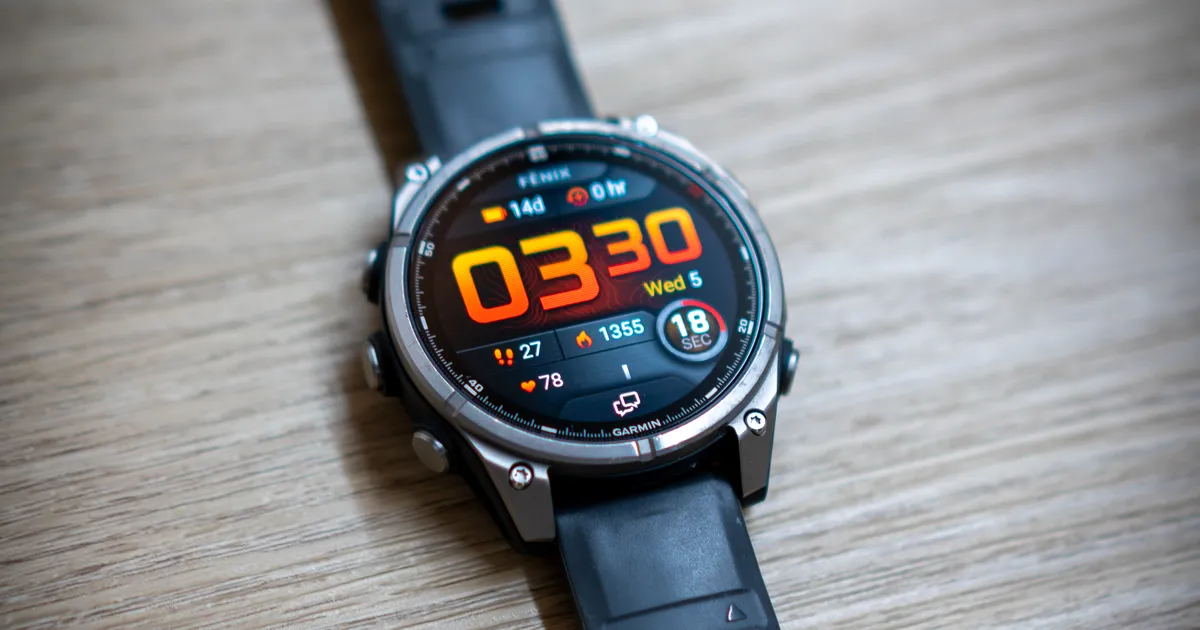Copyright New York Magazine

If you asked me to pick the best sports watch ever made, I wouldn’t even hesitate before naming the Garmin Fenix 8. It tracks virtually every activity you can name (including diving), provides accurate 24/7 health monitoring, averages about two weeks of battery life, and looks great. I’ve tested flagship watches from Suunto, Polar, Coros, Google, Apple, Amazfit, Casio, and more, and the Fenix 8 was just way ahead of the pack. So, when I heard that a Pro version of the Fenix 8 was coming out, I assumed it would easily snatch the throne. The reality is a lot more nuanced. The Fenix line is Garmin’s do-everything multisport watch. When the Fenix 8 came out, Garmin actually cannibalized a couple other of its watches (stealing from the Epix and Descent lines) to create a truly great all-arounder. It has a bright, colorful AMOLED touchscreen; its GPS and vitals tracking sensors are all top of the line; and it just has a great user interface, not to mention a bright LED flashlight (which I now believe should be a standard feature on all watches). It also serves up notifications from your phone, has a built-in voice assistant for basic watch functions, can use Siri or Google Assistant (when paired with your phone), and will even let you respond to messages (Android only). All of that still holds for the Pro version. So where could it be improved? Saved View Want to be emailed when products you’ve saved are over 20% off? Success! You'll get an email when something you've saved goes on sale. Yes New! You can now save this product for later. The biggest new features that distinguish the Fenix 8 Pro from the Fenix 8 is that the 8 Pro finally adds an LTE radio, and it has direct satellite messaging, too. In other words, you can leave your phone at home (or accidentally drop it in a river) and still be able to communicate with family, friends, and emergency services. That’s a big deal, but prepare yourself for some caveats, which we’ll get to momentarily. The other banner feature is brightness. You can get the 8 Pro with an AMOLED screen that roughly doubles the brightness of the original Fenix 8 (which I rarely had trouble reading even in direct sunlight) to an estimated 2,000 nits, or you could opt for the new MicroLED version, which claims to be the brightest smartwatch ever built, coming in at a whopping 4,500 nits. There are some other physical differences, too, most notably that the Fenix 8 Pro is not available in the smallest 43-millimeter size. That’s a real bummer for people with smaller wrists, and that tends to be the preferred size among women. The AMOLED version is available in the usual 47-millimeter and 51-millimeter sizes, but it’s worth noting that the Pro version is a good deal thicker. It’s chunkier by about two to three millimeters depending on the size, and that makes a difference: I’ve definitely found it catches on more things than the Fenix 8 did. It’s also worth noting that while the Fenix 8 had a solar version with screens that charged the battery when in sunlight, the Fenix 8 Pro does not have that option. The other big difference is the price. The Fenix 8 starts at $1,100. That’s already one of the most expensive sports watches you can buy. The Fenix 8 Pro starts at $1,200 and goes up to a staggering $2,000 for the 51-millimeter MicroLED. I’ll tell you right now, unless you spend a lot of time in a white-sand desert at high noon, I cannot see the need to spend that much money for additional brightness. But what about the AMOLED model — is it worth it? I just spent the last month with the 47-millimeter version to find out. Let’s start with the good. The DNA of this watch is the same as the Fenix 8, and basically everything that made that watch great still applies here. It has preinstalled, full-color maps of all of North America, and it has advanced track-back and even rerouting features if you get lost on a hike. For running and cycling, the granularity of the data it delivers is astonishing. Not only is its multiband GPS highly accurate (even among tall buildings, under trees, and in canyons), but its built-in heart-rate monitor is best in class for a wrist-based HRM (I tested it against a chest-strap monitor, which is the gold standard). It also features excellent training and live-coaching features to help you deliver when race day arrives. It counts your waves when you surf, your dive time and depth for free diving and recreational scuba, and your speed and runs while snowboarding. While it isn’t perfect (why can’t I add the Tides widget to the surf activity?), it’s well ahead of its competitors in features and ease of use. While I never had a problem seeing the screen on my 47-millimeter Fenix 8, the 8 Pro is noticeably brighter, and that does make stealing a quick glance while you’re on a bouncy trail run even easier. The speaker on the watch is also a bit louder than on the Fenix 8, which comes in handy when you have to take an unexpected call when you’re in the shower. But, of course, the banner feature here is the LTE and satellite connectivity. While adding this feature is undeniably great, especially in the case of emergencies, there are a lot of quirks, making it not quite the straightforward experience you’d get from an Apple Watch or Pixel Watch. For starters, all of the messaging is done through Garmin’s built-in inReach app (inReach is Garmin’s line of stand-alone satellite tracking and messaging devices). You have to subscribe to Garmin’s inReach service for it to work at all. These plans start at $8 per month and go up from there. All of the inReach plans include unlimited LTE texting, voice messaging, voice calling, and LiveTrack location sharing, as well as satellite SOS, but satellite messaging costs extra, so you’ll want to choose a plan based on how much you think you might need that (or pay 10 cents per message on the most basic plan). The good news is that by routing everything through the inReach system, you don’t need to pay to add a data line for your watch with your wireless carrier. The bad news is that means your watch isn’t linked to your phone number. Garmin will randomly generate a separate number for your watch, and it will be up to you to give it out as you see fit. That’s nice if you want to minimize your interruptions while you’re out in nature, away from your phone, but it’s actually more complicated than just giving someone the number. You have to initiate contact by sending them a message through the inReach app first. They should then be able to text you back, but that’s not the end of it. If you want to be able to send/receive voice notes or voice calls (LTE only), you have to get them to install the inReach app on their phone and set up a (free) account. That’s kind of a pain, and it’s probably more than you want to ask a lot of people to do (a client or customer, for instance). They’d also have to know when to message you at which number. It’s not a bug-free system, either. When I got one friend to set up the inReach app, I was able to send and receive texts over both LTE and satellite without issue, and I was even able to send and receive voice messages over LTE while I was out for a surf. My mom, who doesn’t have the inReach app (and has no interest in setting that up), was able to receive texts from me and respond. Two other friends, however, did not receive any of my text messages. There was no error message on my end, either. The messages appeared to send, but my friends just didn’t get anything, which isn’t great. Using inReach on the watch can also be a bit tricky. It’s not always easy to get to the messaging screen during an activity unless you remember which button to long-press. If you’re in LTE Auto mode (which uses your phone for data when it’s nearby and switches to LTE when it isn’t), then you have to manually hit refresh to check for new messages, which means you may not get an emergency message or call. You can get around that by switching to LTE Always-On, but that will significantly reduce battery life (see below). Composing text messages is limited to either presaved quick messages or typing on a tiny onscreen keyboard. The keyboard is pretty decent for how small it is, but this watch has a voice assistant built into it, so the fact that it doesn’t have voice-to-text for messaging feels like a crime. It’s also a bit weird to have LTE but not be able to stream music, though you can download MP3s or full playlists from Spotify and Amazon Music. Unfortunately, there’s a secondary price to pay for all this connectivity and the brighter screen, and that’s battery life. For the 47-millimeter version I tested, Garmin claims just a one-day reduction in battery life from the Fenix 8 of the same size: 15 days versus 16 days. In reality, it was much worse. Even with the brightness turned to medium, the Always-On display disabled, and LTE/satellite on Auto (which just turns them on as needed, when away from your phone), I was lucky if I got a week, and that was with pretty minimal GPS usage. Worse, if you were in the backcountry and had satellite messaging on full-time, battery life would drop to about two days. In contrast, I regularly got more than two weeks of battery life with the regular Fenix 8, so while the Fenix 8 Pro lasts a lot longer than an Apple Watch or Pixel Watch (roughly 48 hours each), this still feels like a significant drop-off. It’s also worth noting that the Fenix 8 Pro has new and significant competition for off-grid messaging, and from a source we probably wouldn’t have expected until very recently: your phone. The latest iPhones and many new Android phones not only have emergency satellite SOS included for free, but many carriers now provide satellite messaging, too, which allows you to send and receive texts from your own phone number, no additional apps or extra steps required. They might not work internationally, but that is simply much more convenient than being forced to use the inReach Messenger app and some randomly assigned phone number for everything. Garmin’s own stand-alone inReach devices (like the excellent and pocket-size inReach Messenger Plus) have some serious advantages, too. For starters, they use the far more robust Iridium network of satellites, which are constantly orbiting the globe. The Fenix 8 Pro uses a geostationary network called Skylo. That’s generally fine for the U.S. and middle latitudes, but if you go far north or south it could become a problem (looking at you, Alaska). And because the Skylo satellites are higher up, their signal is weaker, so they struggle to communicate when there’s tree cover or when not at just the right angle, which the inReach devices don’t wrestle with. Also, the battery on an inReach Messenger Plus lasts up to 25 days, versus the two days you’ll get from the Fenix 8 Pro when off the grid, so it’s a much better solution for longer backpacking trips. Ultimately, I think this watch is great for very specific-use cases, like if you go on a lot of trail runs or kayak day trips where there’s no reception and you don’t want to have your phone with you, but you need to be reachable by some select contacts. I love that it provides additional safety features like Incident Detection, where it can tell if you’ve had a fall (during certain activities) and can alert your emergency contacts via LTE. But overall, I think the normal Fenix 8, with its better battery life, sleeker profile, and lower price tag, is the better watch for most people, and it remains my top pick. Saved View Want to be emailed when products you’ve saved are over 20% off? Success! You'll get an email when something you've saved goes on sale. Yes New! You can now save this product for later. More From The Strategist Everything I Use to Survive My Annual 24-Hour Flight to Western Australia Ask Kim France: I’m Really Confused About Pants! An Advent Calendar for Every Kind of Person I’ve Been Sleeping So Well Since I Started Spraying Magnesium on My Feet See All



